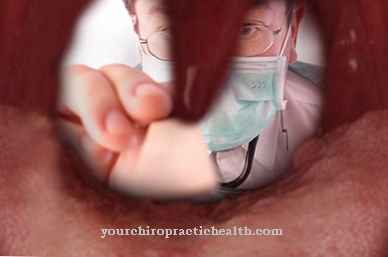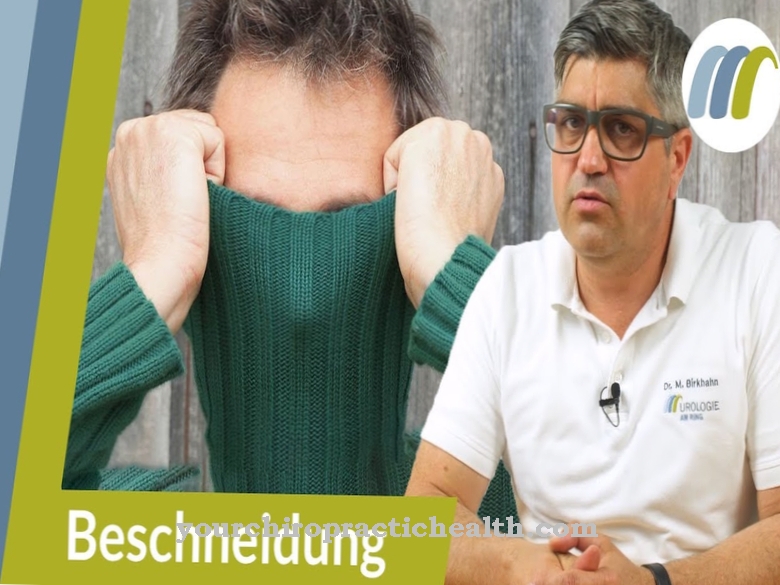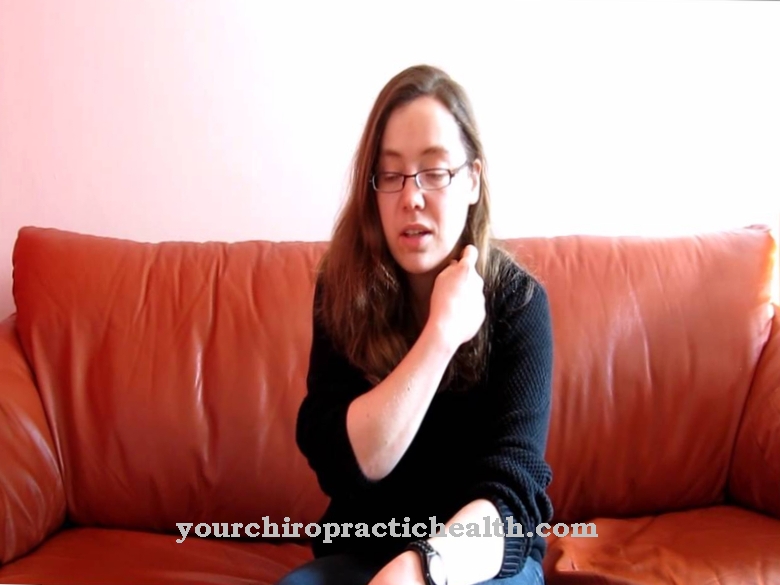Under one Protrusio acetabuli is understood to mean a protrusion of the femoral head and acetabulum in the direction of the small pelvis. It can be both congenital and result from certain diseases.
What is an acetabular protrusion?

© VectorMine - stock.adobe.com
From one Protrusio acetabuli In medicine, this is the term used when the acetabulum and the femoral head bulge towards the pelvis (pelvis minor), which doctors call protrusion. This results in restricted movement of the hips in all directions. If the protrusion is only on one side of the body, the leg can be shortened.
The acetabular protrusion often appears in the context of various diseases, including Marfan's syndrome. This condition is a connective tissue peculiarity that is caused by a gene mutation. The protrusion of the acetabulum was first described in 1824 in Breslau.
According to studies, around a third of all Marfan syndrome patients have to expect an acetabular protrusion, which affects both hip joints. The acetabular protrusion is also known as the Otto Chrobak pelvis. It was named after the German anatomist Adolph Wilhelm Otto (1786-1845) and the Austrian gynecologist Rudolf Chrobak (1843-1910).
Doctors differentiate between a primary and a secondary acetabular protrusion. In the primary form, there should be a dominant inheritance. It shows up primarily in women. A protrusio acetabuli, which is caused by various hip diseases, is called a secondary form. It is recorded equally in both sexes.
causes
The causes of the acetabular protrusion include osteomalacia, coxarthrosis, Marfan's syndrome, fibrous dysplasia and Paget's disease (osteodystrophia deformans). In some cases, traumas or hip replacement surgery are also responsible for the bulging of the acetabulum.
In principle, the acetabular protrusion is a pre-arthrotic deformity. The femoral head sinks into the acetabulum. The transition to the pathological form is fluid. People over 30 years of age are particularly affected by acetabular protrusion. If the protrusion already shows in childhood, a serious course threatens.
Symptoms, ailments & signs
In the initial stage, the acetabular protrusion is still without symptoms. This is also the reason why the disease is often diagnosed so late. Even at an advanced stage, not every patient experiences painful symptoms. In some sufferers, the change in shape causes secondary signs of wear and tear, with cartilage abrasion and deformation of the femoral head.
In such cases, we speak of protrusion coxarthrosis. What is meant is a bulging osteoarthritis of the hip. In the further course of the acetabular protrusion, there is an increasing degree of movement restrictions at the hip joint. These are initially movements such as spreading, stretching and turning. Later, the affected people suffer from pain even when they are at rest, which mainly occurs at night.
In addition, they are no longer able to walk without pain. Even complete hip stiffening is possible. In women there is also the risk of narrowing the small pelvis, which in turn results in mechanical disabilities. In the event of childbirth, this can have a negative effect on the birth process.
Diagnosis & course of disease
Diagnosing acetabular protrusion is not always easy. This is especially true if it is symptom-free, so that it can usually only be discovered by chance. If, on the other hand, typical complaints occur, these are an indication of the protrusion.
Taking X-rays is one of the most important examination methods. On the recordings, the doctor can see that the bottom of the pan is entering towards the pelvis. The criteria of the X-ray examination include a change or loss of the so-called Koehler teardrop. Crossing the inner pelvic line over the hip joint line and increasing the center-bay angle are also considered for an examination. The course of the acetabular protrusion depends on its extent. In some cases it may be necessary to replace the damaged hip joint with an implant.
Complications
Those affected suffer from hip discomfort due to the protrusio acetabuli. However, these complaints do not have to be associated with pain in every case. In most cases, the disease is diagnosed late because the symptoms are ambiguous or only appear in a very mild form.
However, the patient's hip is also heavily worn down by the acetabular protrusion. As the disease progresses, pain can occur without treatment. Especially at night, the pain can be very uncomfortable and thus lead to sleep problems or depression. Restrictions of movement are also not uncommon due to the acetabular protrusion. The stretching and stretching of the entire body is significantly restricted due to the disease.
Treatment of the acetabular protrusion is not associated with complications. In most cases, the symptoms of the disease can be limited with measures of physiotherapy. The life expectancy of the patient is also not influenced or reduced. In serious cases, however, those affected are dependent on surgical interventions in order to be able to continue moving.
When should you go to the doctor?
Acetabular protrusion must always be treated by a doctor. There are various other complications and there is no self-healing, so treatment of the disease is essential. The earlier the doctor is consulted in the case of acetabular protrusion, the higher the chances of a complete cure.
As a rule, the acetabular protrusion does not show itself through any particular complaints or symptoms, so that the disease is unfortunately diagnosed and treated much too late. Early treatment is therefore usually not possible. The affected person suffers from restricted mobility in the hip joint. If these restrictions occur, a doctor should be consulted immediately. In some cases, there is also pain, which can also be accompanied by pain at rest. Especially at night, this can lead to pain and thus sleep problems.
The acetabular protrusion can be diagnosed by a general practitioner or an orthopedic surgeon. However, the treatment depends heavily on the exact severity and type of the disease, so that no general predictions can be made here.
Treatment & Therapy
The treatment of an acetabular protrusion can be performed both conservatively and surgically. Which therapy is ultimately best suited depends on the stage of bulging and the symptoms the patient is suffering from. If there is no pain, you will usually wait.
Secondary coxarthrosis does not necessarily occur in every person. In principle, an X-ray examination is recommended every two years in order to check the further course of the acetabular protrusion.If the patient suffers from pain, this is first fought with conservative means. This can include the administration of painkillers, physiotherapeutic treatments such as physiotherapy exercises, hydrotherapy or electrotherapy.
The loss of weight and the use of orthopedic aids such as walking aids or buffer heels are also considered important. In addition, the patient should move the hip joint slightly. Despite the alleviation of symptoms, conservative therapy cannot prevent the progression of the acetabular protrusion. If the pain and the restricted mobility worsen, an operation is often necessary.
With children there is still the possibility to close the growth plates. In adult patients, it is often useful to insert an artificial hip joint. The long-term results are considered excellent. Problems may arise from a thinned base of the acetabulum, which makes it difficult to anchor the artificial acetabulum in the joint. In such cases, plastic restorative treatments take place, in which the body's own bones are mostly used.
You can find your medication here
➔ Medicines for painprevention
There are no known preventive measures against acetabular protrusion. Sometimes the suffering is already innate.
Aftercare
As a rule, those affected have only a few and only limited follow-up measures available for acetabular protrusion. For this reason, the patient should consult a doctor at the first symptoms and signs of the disease so that further complications can be prevented. As a rule, no independent healing can occur, so that the person concerned is dependent on a medical examination and treatment.
The earlier a doctor is consulted, the better the further course of the disease is usually. The treatment depends heavily on the severity of the acetabular protrusion, so that no general course can be given. In most cases, the patients are dependent on the intake of various drugs, whereby the prescribed dosage and regular intake must be observed.
If anything is unclear or if there are side effects, a doctor should be consulted first. Regular checks by a doctor are also very important. If the disease is treated with an operation, the person affected should take it easy after the operation and especially protect the affected area.
You can do that yourself
The symptoms caused by acetabular protrusion can be relieved with consistent physiotherapy, which noticeably reduces the pain. In everyday life it is important to interpret the physical signs and assess the pain. The sooner the disease is diagnosed, the better the chances of recovery. However, the difficult-to-detect symptoms mean that diagnosis is often very late.
In order to reduce the problems, it is advisable to lower the weight. Orthopedic aids are also available. The use of walking aids or special buffer heels alleviates the restrictions in everyday life. Targeted physiotherapy and slight movements of the hip joint reduce the pain level. At the same time, the ongoing process of wear and tear slows down. However, the progress of the hip disease cannot be stopped, only delayed. Patients should talk to their doctor about the possibility of surgery. Depending on the situation, this procedure can significantly improve the quality of life.
Particularly in sensitive people, the pain and discomfort often lead to psychological problems. In such cases, psychotherapeutic support should take place in addition to the physiotherapeutic measures. In some cities there are self-help groups for osteoarthritis patients who feel that they are understood. The exchange helps to deal with the situation better.





.jpg)



















.jpg)

.jpg)
